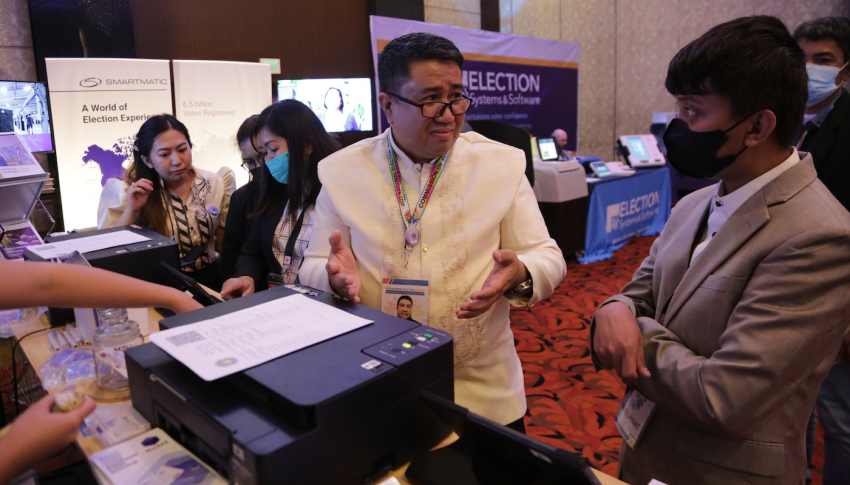
4 prospective bidders so far are eyeing P19-B contract for new voting machines in 2025
The Philippines is set on using new voting machines in the 2025 midterm elections. The procurement process is underway even as the Commission on Elections (Comelec) is in the thick of its preparations for the Oct. 30 barangay and Sangguniang Kabataan elections.
Four companies participated in the market survey conducted by the elections body. These are:
- Smartmatic
- Dominion Voting
- Pivot International
- Miru Systems
Comelec Chairman George Garcia said these four companies confirmed they can deliver the poll body’s requirements for the new machines, which it advertised using the acronym FASTrAC or fully automated system with transparency audit and count.
Garcia told the Philippine Center for Investigative Journalism (PCIJ) that more companies have expressed interest to bid for the contract to supply the machines. “Baka po abutin ng 10 (We might have up to 10 companies),” he told PCIJ in a text message on Sept. 17.
Comelec is on a tight timeline. The terms of reference (TORs) for the fully automated elections system were approved in July. The machines should be a precinct-based Optical Mark Recognition (OMR) or Optical Scan (OpScan) technology, with optional Direct Recording Equipment (DRE) capabilities. It will be an upgrade from the Vote Counting Machines (VCMs) that the country used in the past three national elections in 2016, 2019 and 2022.
The elections body wants the notice to proceed to be issued by February 2024 or 15 months before the 2025 elections, based on its implementation schedule. This will allow time for early delivery of machines, customization of the system, field tests, mock polls, and training.
Garcia said the Comelec hoped to already select the winning bidder before the end of the year and then just wait for the final approval of the 2024 budget before the notice to proceed is issued.
But lawmakers are expected to raise questions about the elections body’s plans during budget deliberations in Congress.
Sen. Aquilino Pimentel, for one, has questions about the dual features of the machines for 2025.
“Comelec is procuring a dual feature machine (for all machines) which made the per unit price more expensive. Why should they do that when the touch screen feature (DRE) is not required as both domestic and overseas voting can be served and counted by OMR technology? Why oh why?” he told PCIJ.
“Be practical. Don't overload the voting machines with features which are ‘not indispensable’. So we don't pay extra cost unnecessarily,” he added.
It will be a lease contract with an option to purchase the machines worth P19 billion (about $345 million), based on the National Expenditure Program (NEP), Malacañang’s proposed budget for 2024. It includes 110,000 units of voting machines, ballot printing services, ballot boxes, training, technical support, and other requirements such as the local source code review.
The total number of units was reduced from the original target of 126,127 units following a budget adjustment in the NEP.
It’s the biggest budget so far allocated for an automated election system in the country.
TOP PHOTO: Election system providers showcase their voting machines at the Election Summit in March 2023. Photo courtesy of Comelec.
Voter woes with Smartmatic
Smartmatic provided electronic services in five previous Philippine national elections. It supplied the technology for the country’s first national automated elections in 2010 – the Precinct Count Optical Scan (PCOS). It was the same technology that was used in the succeeding 2013 midterm elections.
In 2016, the Philippines opted for a new technology. Smartmatic again won the contract to provide Vote Counting Machines (VCMs), which the country used for three elections including last year’s.
Over the years, the company’s record has been tarnished by widespread voter dissatisfaction due to machine breakdowns and other issues. The problems have caused delays in the opening of voting hours, long lines in precincts, rejected ballots, erratic transmission of votes, and prolonged proclamation of winners.
Allegations of cheating have also been made although random manual audits (RMA) – where auditors open ballot boxes and tally the votes manually – have yielded almost 100% accuracy rates.
In the 2016 elections, the accuracy rate was 99.88%. In 2019, it was 99.99%. In 2022, it was 99.93%.
President Ferdinand Marcos Jr. also alleged that he was cheated when he lost his bid for vice president in 2016. It resulted in four years of litigation, where ballot boxes were opened to manually count the votes. But the winning candidate, former Vice President Leni Robredo, even widened her lead in three provinces chosen by the Marcos’ camp. His complaint was dismissed unanimously by the Supreme Court.
Smartmatic was established in 2000. On its website, it claims to have helped 30 countries in modernizing their elections, involving 2 million devices in more than 140 elections and “6.5 billion votes with zero security breaches.”
Apart from the Philippines, the countries include the United States, Zambia, Belgium, United Kingdom, and Argentina.
Disqualify Smartmatic?
Recently, former Information and Communications Technology Secretary Eliseo Rio led a group that filed a petition to disqualify Smartmatic from bidding for the country’s 2025 automated elections. He made allegations of possible manipulation in the May 2022 elections after detecting several transmissions from a single private IP address.
Comelec has denied any rigging in the 2022 elections, but lawmakers are expected to continue to seek clarifications over these highly technical processes during the budget hearings.
Kabataan Rep. Raoul Manuel also pushed for the disqualification of the company. “Posible po ba na given ‘yung experience natin with Smartmatic ay hindi na sila ma-consider? Do we have that option? Kasi lalo na’t gusto natin ang election natin will be credible,” he said in a committee hearing on Aug. 1.
In response, Garcia said there won’t be much the commission can do if Smartmatic’s technology will meet its requirements because the law favours the lowest calculated bidder.
Components of the Automation Project
Component 1: Election management systems, Automated Counting Machine, Consolidated and Canvassing System, other requirements
Component 2: Ballot Printing Services
Component 3: Ballot Boxes
Component 4: Training
Component 5: Technical Support
Component 6: Other requirements such as 1) TEC certification through an International Certification Authority, and 2) Local Source Code Review.
Smartmatic’s contracts with the Philippines have given the company an advantage over its rivals, however. There are concerns that other companies may be disqualified due to a Philippine law requirement for companies to show that they’ve completed a similar project worth at least 50% of the one they are bidding for.
Garcia said they are in talks with the Government Procurement and Policy Board (GPPB) to bring down the requirement to 30% to allow other companies to join the bid, a move that lawmakers supported.
"That stricter requirement must be relaxed so others can participate," said Pimentel.
It is not an ironclad requirement and GPPB allows exceptions, added Sen. Imee Marcos, the President’s sister, during a budget hearing on September 13.
Dominion, Pivot, and Miru
Dominion Voting is a Canadian company that, based on its website, claims to serve more than 40% of US voters with customers in 28 states.
Dominion owns the PCOS technology that was deployed by Smartmatic in the 2010 and 2013 elections.
A dispute between Dominion and Smartmatic caused a lot of headache for the Comelec in the lead-up to the 2013 elections, following Dominion’s cancellation of its license agreement with Smartmatic.
Dominion did not release the source code for the 2013 vote until shortly before the election day.
The law requires the source code – a human-readable representation of the instructions that regulate the operation of the computer that will scan and count the ballots – to be certified.
The legal dispute was eventually resolved and Smartmatic acquired “unlimited and perpetual” access to the technology.
In the 2016, 2019 and 2022 exercises, the country used a different technology – VCMs.
Pivot International lost to Smartmatic, which won the contract for the 2016 elections. A joint venture between Pivot and a local company offered a lower bid than Smartmatic. Its SD cards, however, were found to be incompatible during the testing, resulting in its post-disqualification. The joint venture filed a complaint against Comelec officials for allegedly conspiring to commit irregularities.
Miru Systems Co. Ltd. was also listed among the bidders for the contract to supply the technology in the 2016 vote.
The Korean company claims on its website a total of 20 years of “technical know-how in electronic voting system” since it was formed in 1999. Its machines have been used in South Korea’s national elections, party primaries, union elections, university elections, and consignment elections. They were also used in Kyrgyzstan, Ecuador, Russia, Congo and Iraq.
A Google search of the company’s track record shows at least one instance where it was accused of cheating. In Iraq’s May 12, 2018 elections, the machines of Miru Systems were “at the heart of fraud allegations that led to a manual recount in some areas,” according to a Reuters report. Miru had denied this.
“Concerns about the election count center on discrepancies in the tallying of voters by the voting machines…. and suggestions that the devices could have been tampered with or hacked into to skew the result,” the report added.
Miru Systems said it didn’t find any malfunction when it checked the devices.
In the same year, 2018, Miru Systems also stepped in to provide election technology to the Democratic Republic of Congo amid a tense political climate. Miru was hit with allegations of cheating, which it also denied. Congo would use Miru’s devices again in the 2019 elections.
Features of the new machines
The Philippines has used paper-based OMR technology for the past five national elections. Only the counting and transmission is automated. Voters shade paper ballots, feed into the PCOS or VCMs, which would later transmit the results electronically.
In the 2008 elections in the former Autonomous Region in Muslim Mindanao, Smartmatic provided the DRE technology, which allowed voters to record their votes directly into the machines.
DRE has not been recommended in the Philippine setting, however. It would be unrealistic, experts said, citing time and motion studies which have shown that individual voters take a long time to use the machines.
Based on the TOR, the voting machines for the 2025 elections have the capabilities of both the OMR and DRE systems.
Comelec said the DRE technology could be used for smaller elections such as special elections and plebiscites, where more machines could be deployed for the areas.
For 2025, Comelec also required features such as a 13-inch screen and automatic correction.
Images of the ballots may also be shown to poll watchers at the end of the counting, according to Garcia. He said the watchers can even take images of the ballots to allow manual counting of the votes.
By Carmela Salazar




